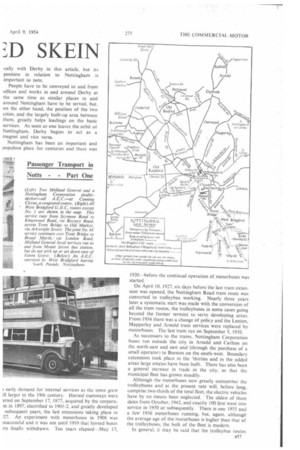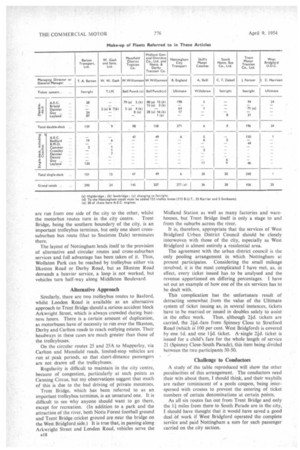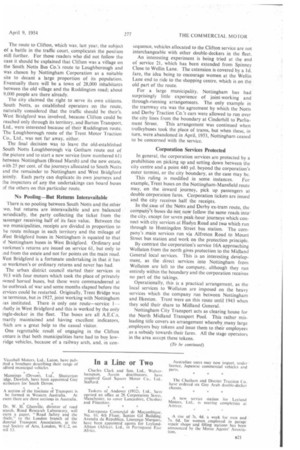A TAN( -LID SKEIN
Page 50

Page 51

Page 52

Page 55

If you've noticed an error in this article please click here to report it so we can fix it.
Whilst Financial Arran, Between Passenger Tr Operators In and Around 11 ham are Straightforwar Geographical Pattern is C
By C. S. Dunbar, mins
IN 1949, when I set out to describe the passenger transport set-up in South Lancashire (The Commercial Motor, July 15), [found the pattern easy to follow, even if the financial arrangements between the operators were involved and difficult to explain lucidly. In that area there is a number of municipal operators with clearly defined boundaries and all (except one) with . undertakings which have grown naturally out of tramway systems. The gaps between the municipal areas are filled in by two large companies, one of which also is
an ex-tramway operator.
It is much the same in the West Riding, but when l recently visited Nottingham to see how that city and its ., environs are served, I found a very different story. The financial arrangements between the operators will not need many sentences to detail, but the geographical pattern is about the most confused I have discovered in my travels about the country. It is riot that there is a vast number of stage operators (as, for instance, in Lincolnshire), but for the most part the build-up of their services is a reminder of the " dog-eat-dog " days.
In the hectic 'twenties, bus proprietors were thrusting out in all directions and when competition became too hot on one route they tried another. This was particularly true of the Nottinghamshire area and it was not uncommon to find several operators on a route. Those wno survived had their position consolidated by the Road Traffic Act and their goodwill became a tangible asset.
As time went by, many wanted to retire and sold their businesses, but they did not always sell to the major operator in their district. so that today, a map of routes within a dozen miles of Nottingham shows many salients where the remaining operators have expanded by this means. It shows, too, several examples o f more than one operator serving the same road without a n y pooling arrangement between them.
Nottingham (population 268,801) and Derby (142,410) a r e focal points only 14 miles apart and between the two is a mixed area of industry and agriculture, whilst to the north is the East Midland coalfield. shall not deal specifi
cally with Derby in this article, but its position in relation to Nottingham is important to note.
People have to be conveyed to and from offices and works in and around Derby at the same time as similar places in and around Nottingham have to be served, but, on the other hand, the position of the two cities, and the largely built-up area between them, greatly helps loadings on the basic services. As soon as one leaves the orbit of Nottingham, Derby begins to act as a magnet and vice versa.
Nottingham has been an important and populous place for centuries and there was
t early demand for internal services as the town grew iIi larger in the 19th century. Horsed tramways were tiled on September 17, 1877, acquired by the corpora)n in 1897, electrified in 1901-2. and greatly developed subsequent years, the last extensions taking place in 27. An experiment with motorbuses in 1906 was [successful and it was not until 1910 that horsed buses :re finally withdrawn. Ten years elapsed—May 17.
1920—before the continual operation of motorbuses was started.
On April 10, 1927. six days before the last tram extension was opened, the Nottingham Road tram route was converted to trolleybus working. Nearly three years later a systematic start was made with the conversion of all the tram routes, the trolleybuses in some cases going beyond the former termini to serve developing areas. From 1934 there was a change of policy and the Lenton, Mapperley and Arnold tram services were replaced by motorbuses. The last tram ran on September 5, 1936.
As successors to the trams, Nottingham Corporation buses run outside the city in Arnold and Carlton on the north-east and east and (through the purchase of a small operator) to Beeston on the south-west. Boundary extensions took place in the 'thirties and in the added areas large estates have been built. There has also been a general increase in trade in the city, so that the municipal fleet has grown steadily.
Although the motorbuses now greatly outnumber the trolleybuses and at the present rate will, before long, comprise two-thirds of the total fleet, the electric vehicles have by no means been neglected. The oldest of them dates from October, 1942, and exactly 100 first went into service in 1950 or subsequently. There is one 1935 and a few 1936 motorbuses running, but, again, although the average age of the motorbuses is higher than that of the trolleybuses, the bulk of the fleet is modern.
In general, it may be said that the trolleyhus routes B17 are run from one side of the city to the other, whilst the motorbus routes turn in the city centre. Trent Bridge, being the southern boundary of the city, is an important trolleybus terminus, but only one short crosssuburban bus route (that to Sneinton Dale) terminates there.
The layout of Nottingham lends itself to the provision of alternative and circular routes and cross-suburban services and full advantage has been taken of it. Thus, Wollaton Park can be reached by trolleybus either via Ilkeston Road or Derby Road, but as Ilkeston Road demands a heavier service, a loop is not worked, but vehicles turn half-way along Middleton Boulevard.
Alternative Approach
Similarly, there are two trolleybus routes to Basford, whilst London Road is available as an alternative approach to Trent Bridge should a serious accident block Arkwright Street, which is always crowded during business hours. There is a certain amount of duplication, as motorbuses have of necessity to run over the Ilkeston, Derby and Carlton roads to reach outlying estates. Their headways in these cases are much greater than those of the trolleybuses.
On the circular routes 25 and 25A to Mapperley, via Carlton and Mansfield roads, limited-stop vehicles are run at peak periods, so that short-distance passengers are not drawn off the trolleybuses.
Regularity is difficult to maintain in the city centre, because of congestion, particularly at such points as Canning Circus, but my observatiQns suggest that much of this is due to the bad driving of private motorists.
Trent Bridge, which has been referred to as an important trolleybus terminus, is an unnatural one. It is difficult to see why anyone should want to go there, except for recreation. (In addition to a park and the attraction of the river, both Notts Forest football ground and Trent Bridge cricket ground are near the bridge on the West. Bridgford side.) It is true that, in passing along Arkwright Street and London Road, vehicles serve the Midland Station as well as many factories and warehouses, but Trent Bridge itself is only a stage to and from the suburbs across the river.
It is, therefore, appropriate that the services of West Bridgford Urban District Council should be closely interwoven with those of the city, especially as West Bridgford is almost entirely a residential area.
The agreement with the urban district council is the only pooling arrangement in which Nottingham at present participates. Considering the small mileage involved, it is the most complicated T have met, as, in effect, every ticket issued has to be analysed and the revenue apportioned on differing percentages. I have set out an example of how one of the six services has to be dealt with.
This complication has the unfortunate result of detracting somewhat from the value of the Ultimate system of ticket issuing as, in several instances, tickets have to be married or issued in doubles solely to assist in the office work. Thus, although 2id. tickets are carried, the 24d.-fare from Spinney Close to Stratford Road (which ili 100 per cent. West Bridgford) is covered by one Id. and one lid. ticket. A-single 2id. ticket is issued for a child's fare for the whole length of service 21 (Spinney Close-South Parade), this item being divided between the two participants 50-50.
Challenge to Conductors A study of the table reproduced will show the other peculiarities of this arrangement. The conductors need their wits about them, I should think, and their waybills are rather reminiscent of a pools coupon, being interspersed With crosses to prevent the entering of ticket numbers of certain denominations at certain points.
As all six routes fan out from Trent Bridge and only the li miles from there to South Parade are in the city, I should have thought that it would have saved a good deal of work if West Bridgford operated the complete service and paid Nottingham a sum for each passenger carried on the city section. The route to Clifton, which was, last year. the subject of a battle in the traffic court, complicates the position still further. For those readers who did not follow the case it should be explained that Clifton was a village on the South Notts Bus Co.'s route to Loughborough and was chosen by Nottingham Corporation as a suitable site to decant a large proportion of its population. Eventually there will be a town of 28,000 inhabitants between the old village and the Ruddington road; about 9,000 people are there already.
The city claimed the right to serve its own citizens. South Notts, as established operators on the route, naturally considered that the traffic should be their's. West Bridgford was involved, because Clifton could be reached only through its territory, and Barton Transport, Ltd., were interested because of their Ruddington route. The Loughborough route of the Trent Motor Traction Co., Ltd., was not far away, either.
The final decision was to leave the old-established South Notts Loughborough via Gotham route out of the picture and to start a new service (now numbered 61) between Nottingham (Broad Marsh) and the new estate, with 25 per cent. of the journeys allocated to South Notts and the remainder to Nottingham and West Bridgford jointly. Each party can duplicate its own journeys and the inspectors of any the undertakings can board buses A the others on this particular route.
No Pooling—But Returns Interavailable
There is no pooling between South Notts and the other wo, but returns are interavailable and are balanced )eriodically, the party collecting the ticket from the




































































































